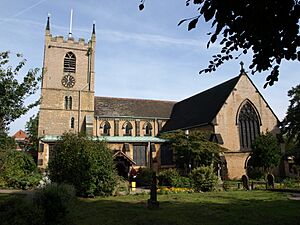Church of St Mary Magdalene, Hucknall facts for kids
Quick facts for kids Church of St Mary Magdalene, Hucknall |
|
|---|---|

The Church of St Mary Magdalene in Hucknall.
|
|
| Denomination | Church of England |
| Churchmanship | Broad Church |
| Website | hucknallparishchurch.org.uk |
| History | |
| Dedication | St Mary Magdalene |
| Administration | |
| Diocese | Southwell and Nottingham |
| Province | York |
The Church of St Mary Magdalene is a historic parish church in the town of Hucknall, Nottinghamshire. It is part of the Church of England and is named after Mary Magdalene, a companion of Jesus.
This church is very important, so it is a Grade II* listed building. This means it is a special building with more than just local interest. It is famous for being the final resting place of the poet Lord Byron and his daughter, the computer pioneer Ada Lovelace.
Contents
History of the Church
The church sits in a quiet churchyard in the middle of Hucknall. The building we see today stands on the same spot as an ancient Saxon church from over a thousand years ago.
From Saxon Times to Today
The oldest part of the church is the tower, which was built in different stages between the 1100s and the 1300s. The porch you walk through to enter the church was added in 1320. For hundreds of years, the church was much smaller. It only had a main hall (the nave), a section for the choir (the chancel), one side aisle, and the tower.
In the 1800s, during the Victorian era, the church was made much bigger. The south aisle was added between 1872 and 1874. Then, in 1887, sections called transepts were added, which give the church a cross shape from above. The Lady Chapel was also rebuilt in 1888 and is a beautiful example of Victorian design.
What used to be the baptistery, where baptisms took place with a 14th-century font, is now a visitor centre. Here, you can learn all about the church's long history from display boards.
The Armenian Stone Cross
In 2004, the church received a special gift: a carved stone cross from Armenia called a Khatchkar. It was given to thank the people of Britain for helping to rebuild the Lord Byron School in Gyumri, Armenia. The school had been destroyed in an earthquake in 1988. The stone was first kept at a local school before being moved to the church.
Famous People Buried Here
The church is well-known because it is the traditional burial place for the Byron family.
The Byron Family Vault
A family vault for the Byron family is located inside the church. Most of the Lords Byron are buried here, including the famous poet Lord Byron.
His daughter, Ada, Countess of Lovelace, is also buried with him. Ada was a brilliant mathematician and is often called the world's first computer programmer. There is a small memorial to Lord Byron inside the church.
Other Notable Burials
Other well-known people are buried in the church and its churchyard:
- Ben Caunt (1815–1861), a famous heavyweight boxing champion.
- Zachariah Green (1817–1897), a local man known for his kindness and for helping others (a philanthropist).
Art and Treasures Inside
The church is filled with beautiful art and interesting historical objects.
Amazing Stained Glass
The church has one of the country's largest collections of stained glass windows made by the artist Charles Eamer Kempe. There are 25 of his windows in the church, most of which were added in the 1880s. They fill the church with coloured light and tell stories through their detailed pictures.
Historic Painting
There is a large painting by the artist Daniel Maclise from 1869. It shows a scene from a Bible story about Jesus.
The Church Bells and Clock
The sounds of the church come from its historic bells and clock.
The Ring of Eight Bells
St Mary Magdalene has a set of eight ringing bells that were installed in 1958. There is also a much older bell from the 14th century called the Angelus bell. It was a gift from the poet Lord Byron. This bell is so old and precious that no one knows its exact weight, as they don't want to risk breaking it by moving it.
The Tower Clock
The first clock was put in the tower in 1685. The clock we see today was installed in 1882. It has four faces, one on each side of the tower. It is a mechanical clock, which means it doesn't use electricity. It has to be wound up by hand once every week to keep it ticking.
The Church Organ
The church used to have a large pipe organ, which was installed in 1976. This organ was later sold to a school. In 1992, a modern electronic organ was installed, which is what is used for music in the church today.
Gallery





